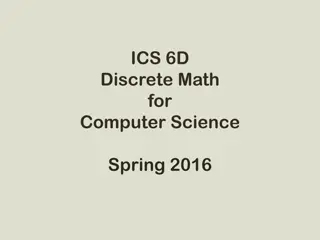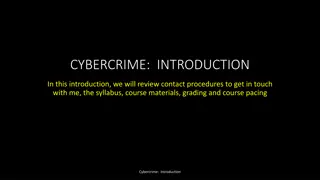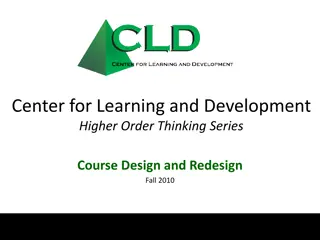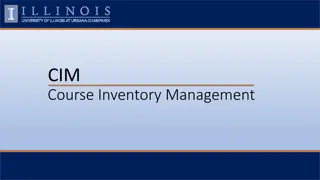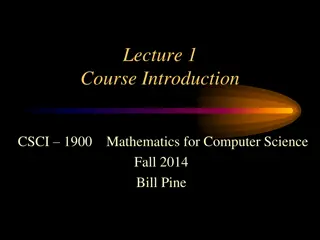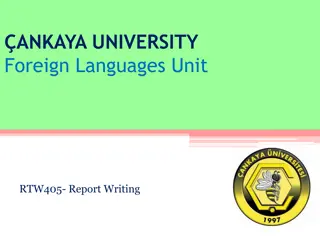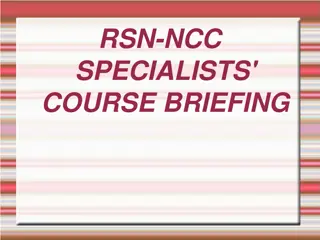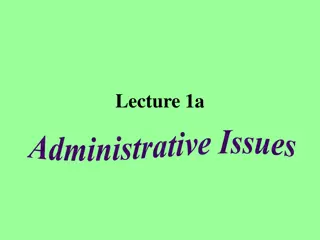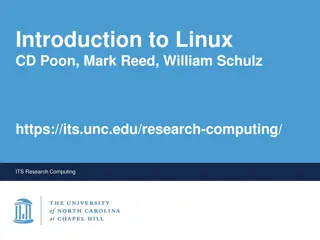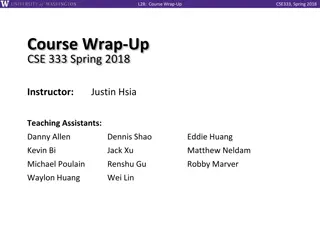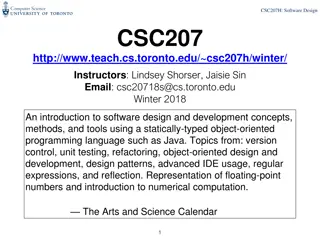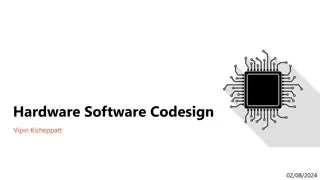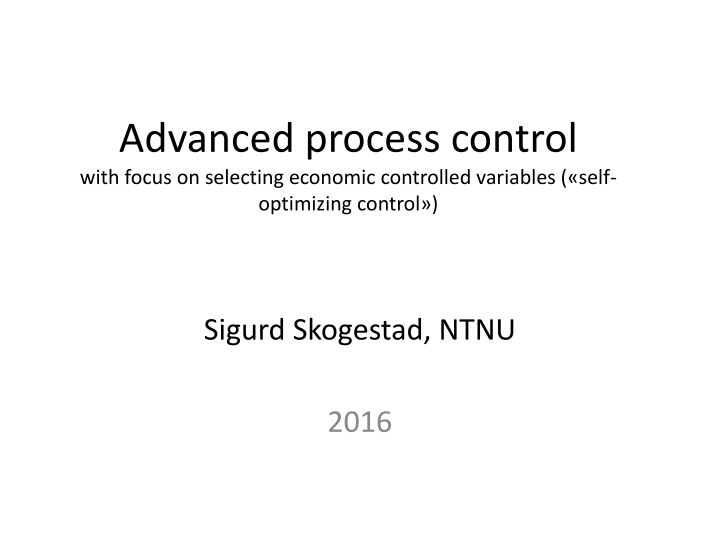
Advanced Process Control with Economic Optimization by Sigurd Skogestad
Dive into the world of process control with a focus on economic optimization and self-optimizing control in chemical plants. Learn how to identify active constraints, self-optimizing variables, stabilize controlled variables, and design regulatory loops with Sigurd Skogestad at NTNU. Explore topics like plantwide control, PID tuning, and advanced control strategies through a series of lectures and exercises.
Download Presentation

Please find below an Image/Link to download the presentation.
The content on the website is provided AS IS for your information and personal use only. It may not be sold, licensed, or shared on other websites without obtaining consent from the author. If you encounter any issues during the download, it is possible that the publisher has removed the file from their server.
You are allowed to download the files provided on this website for personal or commercial use, subject to the condition that they are used lawfully. All files are the property of their respective owners.
The content on the website is provided AS IS for your information and personal use only. It may not be sold, licensed, or shared on other websites without obtaining consent from the author.
E N D
Presentation Transcript
Advanced process control with focus on selecting economic controlled variables ( self- optimizing control ) Sigurd Skogestad, NTNU 2016
Course information 7 lectures by Sigurd + 2 industrial lectures Time to be determined at the end 6 exercises + help sessions Exercises count 20% of the grade of the module Exercise hours to be determined at the end
Course Summary This course is about how to operate and control complete chemical plants Find active constraints + self-optimizing variables (CV1). (Economic optimal operation) Locate throughput manipulator (TPM) Gas pedal Select stabilizing CV2 + tune regulatory loops SIMC PID rules Design supervisory layer (control CV1) Multi-loop (PID) ++ MPC 1. 2. 3. 4.
Plantwide process control Part 1 : Plantwide control Part 2 : More on self-optimizing control. Part 3 : Consistent inventory control, TPM location, Structure of regulatory control layer Part 4 : PID tuning Part 5 : Advanced control and case studies
Part 1: Plantwide control Introduction to plantwide control (what should we really control?) Introduction. Objective: Put controllers on flow sheet (make P&ID) Two main objectives for control: Longer-term economics (CV1) and shorter-term stability (CV2) Regulatory (basic) and supervisory (advanced) control layer Optimal operation (economics) Define cost J and constraints Active constraints (as a function of disturbances) Selection of economic controlled variables (CV1). Self-optimizing variables.
Part 2: Self-optimizing control theory Ideal CV1 = Gradient (Ju) Nullspace method Exact local method Link to other approaches Examples, exercises
Part 3: Regulatory (stabilizing) control Inventory (level) control structure Location of throughput manipulator Consistency and radiating rule Structure of regulatory control layer (PID) Selection of controlled variables (CV2) and pairing with manipulated variables (MV2) Main rule: Control drifting variables and "pair close" Summary: Sigurd s rules for plantwide control
Part 4: PID tuning PID controller tuning: It pays off to be systematic! Derivation SIMC PID tuning rules Controller gain, Integral time, derivative time Obtaining first-order plus delay models Open-loop step response From detailed model (half rule) From closed-loop setpoint response Special topics Integratingprocesses (level control) Other special processes and examples When do we need derivative action? Near-optimality of SIMC PID tuning rules Non PID-control: Is there an advantage in using Smith Predictor? (No) Examples
Part 5: Advanced control + case studies Advanced control layer Design based on simple elements: Ratio control Cascade control Selectors Input resetting (valve position control) Split range control Decouplers (including phsically based) When should these elements be used? When use MPC instead? Case studies Example: Distillation column control Example: Plantwide control of complete plant Recycle processes: How to avoid snowballing
Course Plan 2016 Week/Date Week 34 / 22.08. Lecture 0. Introduction Exercise Exercise 1 out (2 weeks) 1. Plant-widecontrolprocedure 2. Self-optimizingcontrol 3. Self-optimizingcontrol Week 35 / 29.08. Week 36 / 05.09. Exercise 1 deadline Exercise 2 out (1 week) Exercise 2 deadline Week 37 / 12.09. 4. Self-optimizingcontrol Exercise 3 out (1 week) Exercise 3 deadline Exercise 4 out (2 weeks) Week 38 / 19.09. 5. Regulatory layer, TPM Selection Week 39 / 26.10. Week 40 / 03.10. 6. ControllerTuning 7. Advanced controlstructures Exercise 4 deadline Exercise 5 out (2 weeks) Week 41 / 10.10. Week 42 / 17.10. Exercise 5 deadline Exercise 6 out (2 weeks) Week 43 / 24.10. Week 44 / 31.10. Exercise 6 deadline Lecturer: Exercises: Sigurd Skogestad (skoge@ntnu.no) Julian Straus (julian.straus@ntnuno) Note, that the days of the lecture may change. There will be two guest lectures given by Stig Strand: MPC application in Statoil Krister Forsman: Advanced process control in Perstorp The dates of both guest lectures have to be defined


